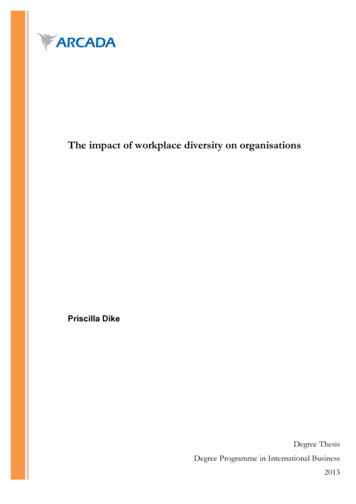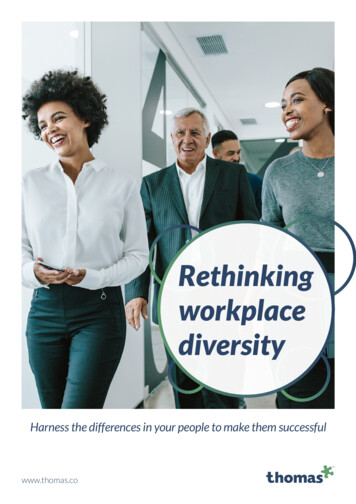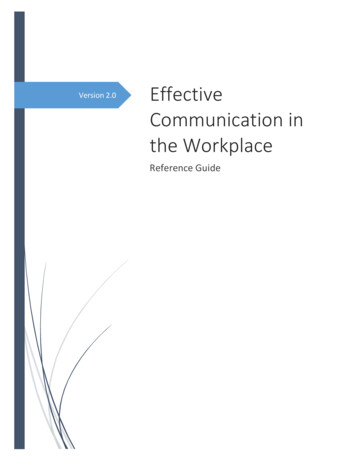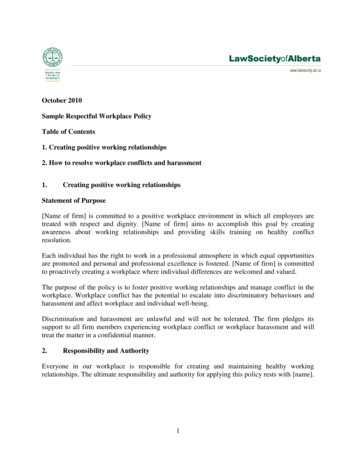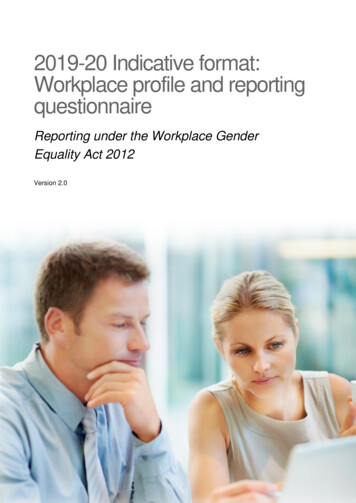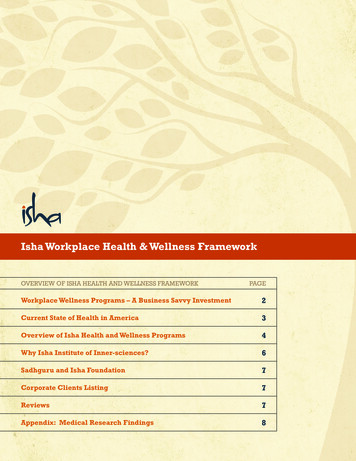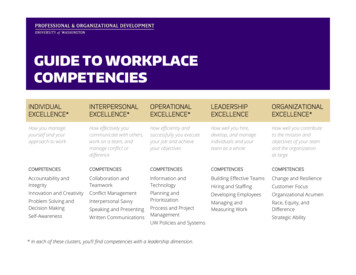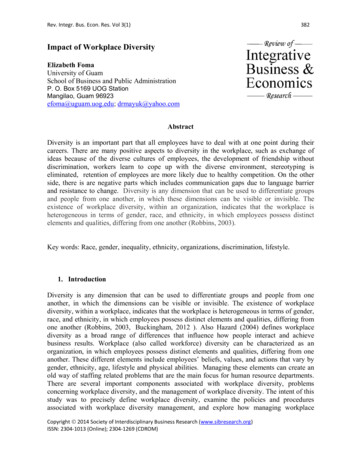
Transcription
Rev. Integr. Bus. Econ. Res. Vol 3(1)382Impact of Workplace DiversityElizabeth FomaUniversity of GuamSchool of Business and Public AdministrationP. O. Box 5169 UOG StationMangilao, Guam 96923efoma@uguam.uog.edu; drmayuk@yahoo.comAbstractDiversity is an important part that all employees have to deal with at one point during theircareers. There are many positive aspects to diversity in the workplace, such as exchange ofideas because of the diverse cultures of employees, the development of friendship withoutdiscrimination, workers learn to cope up with the diverse environment, stereotyping iseliminated, retention of employees are more likely due to healthy competition. On the otherside, there is are negative parts which includes communication gaps due to language barrierand resistance to change. Diversity is any dimension that can be used to differentiate groupsand people from one another, in which these dimensions can be visible or invisible. Theexistence of workplace diversity, within an organization, indicates that the workplace isheterogeneous in terms of gender, race, and ethnicity, in which employees possess distinctelements and qualities, differing from one another (Robbins, 2003).Key words: Race, gender, inequality, ethnicity, organizations, discrimination, lifestyle.1. IntroductionDiversity is any dimension that can be used to differentiate groups and people from oneanother, in which the dimensions can be visible or invisible. The existence of workplacediversity, within a workplace, indicates that the workplace is heterogeneous in terms of gender,race, and ethnicity, in which employees possess distinct elements and qualities, differing fromone another (Robbins, 2003, Buckingham, 2012 ). Also Hazard (2004) defines workplacediversity as a broad range of differences that influence how people interact and achievebusiness results. Workplace (also called workforce) diversity can be characterized as anorganization, in which employees possess distinct elements and qualities, differing from oneanother. These different elements include employees’ beliefs, values, and actions that vary bygender, ethnicity, age, lifestyle and physical abilities. Managing these elements can create anold way of staffing related problems that are the main focus for human resource departments.There are several important components associated with workplace diversity, problemsconcerning workplace diversity, and the management of workplace diversity. The intent of thisstudy was to precisely define workplace diversity, examine the policies and proceduresassociated with workplace diversity management, and explore how managing workplaceCopyright 2014 Society of Interdisciplinary Business Research (www.sibresearch.org)ISSN: 2304-1013 (Online); 2304-1269 (CDROM)
Rev. Integr. Bus. Econ. Res. Vol 3(1)383diversity can effect diversity awareness and employees job satisfaction. . In the past, companieswere driven towards creating a homogenous workplace in which employees acted and thoughtin identical way. “Nowadays managers and supervisors are looking at a workplace that issomehow different from those managed by their ancestors” (Wigglesworth, 1997, p. 18).Managing diversity is focused on the assumption that diverse segments will create newmethods of working together and that morale, profit, and productivity will increase(Schoenfeldt, and Shaw, 1999). Sadri and Tran, 2002, p. 228). These authors stated thatmanaging diversity includes building specific skills and creating policies that increases the bestwork behaviors and attitudes from each employee. Implementing workplace diversity hasbecome a major focus in many Human Resource departments. In order to meet the demands ofmodern technologically advanced society, corporations must rethink what diversity means andhow the concepts of developing, valuing, and managing a truly diverse corporation must gobeyond traditional strategies (Easley, 2001, p. 38). Human resource management allowsHuman Resource departments to strategically utilize personnel, in a fashion that will meet thedemands of society, through improvements in the corporation’s productivity and performance.Human resources in their role of managing diversity must be aware of problems and elementsthat may impact this role. Several elements are included in managing workplace diversity. Oneof the main elements is equal employment opportunity. Equal employment opportunitywarrants the treatment of employees in a fair and impartial way, in all aspects of employment.Equal Employment Opportunity (EEO) regulation includes legislation and policies that enforcefair and impartial treatment of employees. The Equal Employment Opportunity Commissionand Office of Federal Contract Compliance Programs are agencies that are responsible forenforcing legislation and policies. In addition to Equal Employment Opportunity, affirmativeaction, and discrimination law are also elements that corporations use to manage and regulateworkplace diversity.Almost everyone is now able to communicate and work with other people from different partsof the world due to the advancements in technology. One great proof of the technologyadvancement is the outsourcing of many administrative jobs. U.S companies can now hire theirHuman Resource personnel from India or Philippines and have them do the HR work in lessthan half the price they will pay workers in US. Because of this, many question the importanceof diversity in the workforce, but studies have shown that having a diverse workforce proves tobe a beneficial asset in a company. Workplace diversity despite having numerous benefitsdoes have its flaws. Workplace diversity should be one of the top things businesses todayshould address. Businesses should prioritize hiring diverse employees because of the manygreat things associated with it. The main goal of workplace diversity management is theprohibition of discrimination against individuals, which would cause them to be unfairlydifferentiated from coworkers. In addition to globalization, diversity has also increased as aresult of an increase in women and people with disabilities entering the work force. One of thetasks of managing workplace diversity is to recognize the differences among individuals andprovide opportunities and means for individuals to contribute their talents to the organization.2.Three Theories about workplace diversityCopyright 2014 Society of Interdisciplinary Business Research (www.sibresearch.org)ISSN: 2304-1013 (Online); 2304-1269 (CDROM)
Rev. Integr. Bus. Econ. Res. Vol 3(1)384The fundamental to social justice within business is to make certain that the workplace remainsa place of diversity. Not only does this ensure recognition of basic rights and liberties, but italso creates an atmosphere of trust that is often lacking between corporation and consumer.2.1 The meaning of diversity has changed from what it used to be in the past. One theory statesthat, before businesses can implement a strategy to get diversity, they should gain a clearunderstanding of what it means. According to this theory, many people are still focused on oldmodels of diversity, which focus on social justice issues such as concerning gender orrace. Conversely, diversity now should focus on creating an atmosphere that fostersconnection.2.2 A second theory requires leveraging diversity in order to attract new clients. By building adiverse team of employees, a business will be better able to reach specific audiences. Staffinga company with one demographic would make it very hard to connect with anyone outside ofthat demographic.2.3 A third theory requires that businesses focus more on understanding the client, rather thanfocusing on workplace diversity. Making a product marketable is more about clear advertising,rather than anything that goes on behind closed doors.When it comes down to it, there are many different definitions of diversity and many differentways to achieve it. It has now been a long time since anti-discrimination laws were enteredinto the books, but that does not mean that we should stop focusing on them. Implementing adiverse working class is fundamental to maintaining social justice on multiple levels. Itsimportance should never be forgotten and should always be a tool for positive changewhenever possible.2. Literature ReviewThe author of this paper chose to analyze PepsiCo and their company’s diverseenvironment. PepsiCo’s motto for their employees states that: “If a company supports you, itgives you the extra push you need.” This means that they support their employees all the wayto ensure that they are productive to the company. The author felt that PepsiCo would be thebest company to look at as far as diversity is concerned, because on top of being a companywith a strong presence in the United States, it is also the biggest food manufacturing companyin U.S and Canada for three straight years. This literature review was based on the informationPepsiCo provided in their website. PepsiCo shows really great support for diversity. Accordingto their website, their workforce in 2012 was composed of 31% women. PepsiCo recentlyimplemented the Strategies for Success Women's Program. The program is designed toaccelerate female managers within PepsiCo to ensure they have the same chance of promotionas men in a vacant position. Also in 2012, PepsiCo was awarded a perfect 100 on its CorporateEquality Index by the Human Rights Campaign. PepsiCo defines diversity as all the uniquecharacteristics that make up each of us: personality, lifestyle, thought processes, workexperience, ethnicity, race, color, religion, gender, gender identity, sexual orientation, maritalstatus, age, national origin, disability, veteran status or other differences.Copyright 2014 Society of Interdisciplinary Business Research (www.sibresearch.org)ISSN: 2304-1013 (Online); 2304-1269 (CDROM)
Rev. Integr. Bus. Econ. Res. Vol 3(1)385PepsiCo has a slogan which states: “Performance with Purpose”. This simply meansthat, Pepsico remain steadfastly dedicated to building a profitable and sustainable 21st centurycorporation–one that is a good investment for their shareholders, a good environment for theiremployees, a good citizen in their communities and a good steward of their planet’s resources.PepsiCo has proven their practice of diversity in that, Indra K. Nooyi who is their Chairman andChief Executive Officer is a woman.3. Theoretical Framework and HypothesisThere are two questions which need to be answered: How is workplace diversity characterized?What effect does managing workplace diversity have on diversity awareness and employeesjob satisfaction?H1: There is a relationship between diversity awareness, as measured by the WorkplaceDiversity comparison, and employee job satisfaction, as measured by the Job Satisfactionobservation.H01: There is no relationship between diversity awareness, as measured by the WorkplaceDiversity comparison, and employee job satisfaction, as measured by the Job Satisfactionobservation.H2: There is a difference in diversity awareness by varying demographic characteristics,including years of service, gender, ethnicity, and age.H02: There is no difference in diversity awareness by varying demographic characteristics,including years of service, gender, ethnicity, and age.The results showed that a moderate relationship exists between diversity awareness asmeasured by comparison and employee job satisfaction as measured by observation and thatdiversity demographics can potentially impact diversity awareness.4. Research MethodThe research relied heavily on studies and articles concerning workplace diversity. Theauthor used articles that answered the question of impact of diversity to workplace andpersonal experiences over the years of working in different organizations and government,which enabled those findings to formulate and guide her opinion of diversity in the workplace,hence Qualitative Research/Analysis. This paper will cover the impacts of workplace diversity.The paper will discuss the benefits of workplace diversity, followed by the challenges thatemployers face with diversity, and ultimately the solutions that were developed throughanalyzing the benefits and challenges.5. Data Analysis and DiscussionCopyright 2014 Society of Interdisciplinary Business Research (www.sibresearch.org)ISSN: 2304-1013 (Online); 2304-1269 (CDROM)
Rev. Integr. Bus. Econ. Res. Vol 3(1)386The following is the data analysis and discussion in relation to research findings andPepsiCo’s article from their online website. The paper will discuss and analyze the impacts of adiverse workplace and the benefits, challenges, and solutions to a better work environment.6. Benefits of a Diverse WorkplaceThere are several benefits of a diverse workplace. Some economic benefits includeincrease in the pool of qualified personnel from different backgrounds, and it widens the scopeof eligible candidates for hire. Another benefit of a diverse workplace is it improvescommunication with an organization’s clients. Additionally, a sense of harmony is recreatedwhen a company recognizes and accommodates the differences within its diverse workforce. Adiverse workplace increases productivity, increases creativity, and improves problem solving.A diverse workplace helps build work practices that create harmony. If a company isable to recognize the differences between its employees, it will be able to formulate workpractices that will not exclude a certain culture. Also, if a company is able to develop desirablework practices that strives to unite all the employees together despite their differences, no oneindividual will feel left out or unsure about their position within the company. This in turnincreases productivity among the employees (McLauren, 2012).A diverse workplace also allows an organization to effectively execute its plans(Kapoor, C. 2011). As previously stated, if a company recognizes the differences among itsdiverse em
diverse workplace and the benefits, challenges, and solutions to a better work environment. 6. Benefits of a Diverse Workplace There are several benefits of a diverse workplace. Some economic benefits include increase in the pool of qualified personnel from File Size: 280KBPage Count: 9
